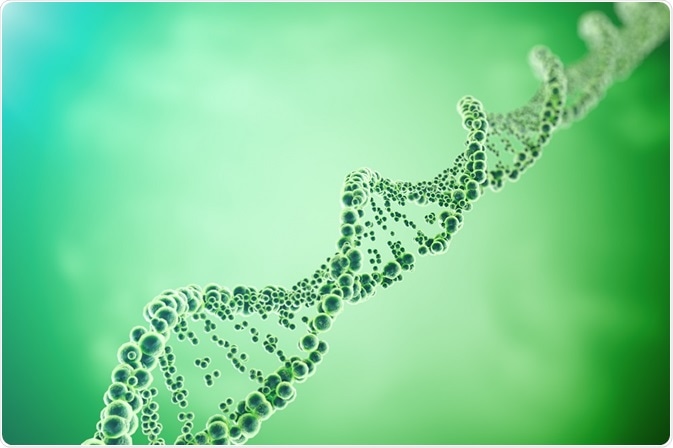DNA loops are produced when the DNA slips through ring-like motor proteins. This process is known as DNA loop extrusion. Loop extrusions help in holding the local DNA regions together. Many theories have been proposed to explain DNA loop extrusion.
 Image Credit: Rost9 / Shutterstock
Image Credit: Rost9 / Shutterstock
Loop extrusion by the structural maintenance of chromosomes (SMC) family of ATPases
Ganji M et al., and Fudenberg G et al., postulated that the SMC family of ATPases, such as condensin and cohesion, extrude DNA into large loops. Energy from ATP hydrolysis helps the SMC proteins to translocate along the chromatin fibers.
By real-time imaging of DNA loop extrusion, it was observed that a single complex of condensin could extrude many kilobase pairs of DNA. The growth of these chromatin loops stop when the SMC proteins, such as the cohesin rings, encounter the CTCF proteins in the convergent direction.
These CTCF proteins are present at the borders of topologically associating domains (TADs). TADs are megabase-long domains of chromatin that form the fundamental structural and building blocks of human interphase chromosomes. For a stable chromatin loop, the C terminal of the CTCF protein should meet the cohesion rings.
Loop extrusion by DNA-loop-extruding enzymes
In this theory, DNA-loop-extruding enzymes are thought to be bound to a DNA lattice of finite length. Each enzyme is assumed to have two binding domains that can bind and bridge two DNA sites.
When SMC proteins such as cohesion (also known as machines) bind to the DNA lattice, it associates with the adjacent lattice sites. Alipour E et al., further postulated that ATP hydrolyzes each binding domain to move along the DNA.
The protein link between each binding domain leads to extrusion of a DNA loop. This association of machines and DNA, known as infinite processivity, forms a disordered distribution of small loops.
However, if dissociation of the machine and DNA occurs, known as finite processivity, highly stable and large DNA loops are formed with very less fluctuations.
Loop extrusion by transcription-induced supercoiling
There is no established evidence that cohesin rings act as active DNA translocases to give rise to loop extrusions. However, transcription-induced supercoiling is a well-documented process in living organisms.
This process pushes TAD cohesin rings actively along the chromatin fibers, forming cohesin ‘handcuffs’. These handcuffs are then released by the DNA topoisomerase IIB (TOPIIB) enzyme present on the TADs borders to form DNA extrusion loops.
Loop extrusion by osmosis
Yamamoto T and Schiessel M analyzed the cohesin ring dynamics on a loop with cohesin loaders in the middle of the loop and unloaders at the loop ends. This mechanism assumes that cohesin monomers bind to the loader more frequently than cohesin dimers.
The cohesin dimers facilitated DNA loop extrusion due to osmotic pressure exerted by the cohesin monomers. However, this theory holds true only if the following criteria are met:
- Rare loading of cohesin dimers onto the chromatin fiber.
- Cohesin monomers do not form dimers on the chromatin fiber.
Loop extrusion driven by thermal motion (diffusive extrusion)
Although recent high-throughput version of chromosome conformation capture (HiC) data have suggested that CTCF binding motifs and cohesin rings lead to loop extrusion, a suitable motor protein that generates these loops is yet to be found.
Brackley et al., used HiC to carry out simulation experiments in order to shed more light on whether diffusive extrusion could generate DNA loops. Their simple 1D simulation demonstrated a ratchet effect.
In this simulation, different cohesin handcuffs were continually loaded and uploaded from a chromatin fiber. It was observed that if the handcuffs were loaded at random locations, a number of loops were formed side-by-side competing for space.
However, if the handcuffs were loaded at a single location, it led to a ratchet effect. This ratchet effect prevented the first handcuff from diffusing back towards the loading site, thus creating an osmotic pressure leading to diffusive loop extrusion.
How does DNA fold? The loop extrusion model
Loop extrusion is an important step in ensuring that genetic information is distributed evenly during cell division. Understanding the mechanisms involved in DNA loop extrusion is a crucial step in tracing the molecular origins of many genetic and chronic diseases.
Further Reading
Last Updated: Feb 26, 2019